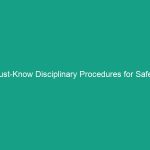Introduction
In today’s fast-paced world, ensuring health, safety, and environmental (HSE) protection in laboratory settings is paramount. Laboratories can be hazardous environments, with numerous risks posed by chemicals, biological agents, and equipment. Implementing effective laboratory Safety practices is essential not only for the Safety of personnel but also for compliance with legal Regulations and Standards. The goal of this article is to explore essential safety practices, highlight common risks, and provide insights on how to mitigate them effectively.
Understanding Regulatory Frameworks
Laboratory safety is governed by a range of regulatory frameworks that vary by country and industry. Understanding these regulations is critical for creating a safe working Environment.
Key Regulatory Bodies
Several organizations oversee laboratory safety regulations. In the United States, the Occupational Safety and Health Administration (OSHA) plays a vital role, setting standards that ensure safe working conditions. The Environmental Protection Agency (EPA) also regulates hazardous waste management in laboratories, while the Centers for Disease Control and Prevention (CDC) provides guidelines for biohazardous materials.
Importance of Compliance
Compliance with these regulations is not just about avoiding fines; it is about protecting lives. Non-compliance can lead to serious accidents, health issues, and even lawsuits. Regular audits and Training programs can help ensure that laboratories adhere to safety regulations while fostering a culture of safety.
Best Laboratory Safety Practices
Implementing Best Practices is crucial for minimizing risks associated with laboratory work. These practices encompass a variety of strategies, including proper training, equipment Maintenance, and emergency preparedness.
Proper Training and Education
One of the cornerstones of laboratory safety practices is ensuring that all personnel are adequately trained. Training should cover the proper handling of chemicals, the use of Personal Protective Equipment (PPE), and emergency Procedures. Regular refresher courses can help reinforce knowledge and adapt to new safety protocols.
Use of Personal Protective Equipment (PPE)
Personal protective equipment is essential in safeguarding laboratory personnel from injuries and exposure to hazardous materials. Common Types of PPE include gloves, goggles, lab coats, and face shields. It is vital to choose the right PPE for the specific tasks being performed and to ensure that all employees wear them consistently.
Safe Handling and Storage of Chemicals
Understanding how to handle and store chemicals safely is a critical aspect of laboratory safety practices. Chemicals should be clearly labeled, and safety data sheets (SDS) must be readily available. Additionally, incompatible chemicals should be stored separately to prevent dangerous reactions.
Regular Equipment Maintenance
All laboratory equipment should be regularly maintained and calibrated to ensure it operates safely and effectively. Equipment failures can lead to hazardous situations, so setting a maintenance schedule and keeping detailed records can help mitigate these risks.
Emergency Preparedness and Response
Despite best efforts, accidents can still occur. Therefore, having a robust emergency preparedness plan is critical. This includes clear evacuation routes, accessible first aid kits, and regular emergency drills to ensure that all personnel know their roles during an emergency.
Common Risks in Laboratories
Identifying common risks is essential for implementing effective Safety Measures. Some of the most prevalent Hazards include chemical exposure, biological risks, and equipment-related injuries.
Chemical Exposure
Chemical exposure can occur through inhalation, skin contact, or ingestion. Chemicals can be toxic, corrosive, or flammable. Proper ventilation, fume hoods, and local exhaust systems are essential in minimizing exposure. Additionally, training staff on recognizing the symptoms of chemical exposure is vital for timely intervention.
Biological Hazards
Laboratories that work with biological materials face unique risks, such as exposure to pathogens or allergens. Biosafety levels (BSL) dictate the Safety Measures required for working with different types of biological agents. Following BSL guidelines, including using biosafety cabinets and proper waste disposal methods, is essential for minimizing risks.
Equipment-Related Injuries
Laboratory equipment poses various risks, from sharp instruments to high-voltage machines. Training on safe equipment usage and implementing lockout/tag-out procedures can help prevent injuries. Additionally, ensuring that all equipment is in good working order and that safety features are functional is crucial.
Case Studies: Learning from Incidents
Analyzing past incidents can provide valuable insights into improving laboratory safety practices. By learning from mistakes, laboratories can enhance their safety protocols and prevent future accidents.
The 2011 UCLA Incident
In 2011, a tragic incident at the University of California, Los Angeles (UCLA) resulted in the death of a researcher due to exposure to a toxic chemical. The event highlighted the importance of proper training, strict adherence to safety protocols, and the need for regular inspections. In response, UCLA implemented more rigorous training programs and revised its safety protocols.
Lessons from the 2015 Harvard Lab Explosion
A 2015 explosion at a Harvard University laboratory serves as another cautionary tale. The explosion was caused by the improper handling of chemicals. This incident underscored the importance of proper labeling, storage, and understanding chemical properties. Following the incident, Harvard reinforced its safety training and improved its chemical inventory management.
Challenges in Implementing Safety Practices
Despite the importance of laboratory safety practices, several challenges can hinder their implementation. Addressing these challenges is crucial for enhancing safety in laboratory environments.
Cultural Resistance
One significant challenge is cultural resistance to change. Some laboratory personnel may be accustomed to certain practices and may be reluctant to adopt new safety protocols. Encouraging a culture of safety through leadership support, open communication, and recognition of safe behaviors can help overcome this resistance.
Resource Limitations
Resource limitations, such as budget constraints, can hinder the implementation of safety measures. Laboratories may struggle to purchase necessary PPE, equipment, or training materials. Seeking grants, collaborating with other institutions, or reallocating funds can help address these limitations.
Keeping Up with Technological Advances
As technology advances, laboratories must continuously adapt their safety practices. New equipment and procedures may introduce unfamiliar risks. Regular training and updates on new technologies will ensure personnel remain informed and competent in their safety practices.
Future Trends in Laboratory Safety
As we look to the future, several trends are emerging in laboratory safety that can shape the way laboratories operate. These trends emphasize the need for innovation and adaptation in safety practices.
Increased Integration of Technology
Technology is playing a more significant role in enhancing laboratory safety. Automated systems for monitoring and reporting safety incidents can provide real-time data, allowing for prompt responses to potential hazards. Additionally, virtual reality (VR) training modules are becoming popular for immersing personnel in safety scenarios without real-world risks.
Focus on Mental Health and Well-being
Recognizing that mental health is equally important in laboratory safety is gaining traction. Stress and burnout can lead to lapses in safety practices. Implementing programs that promote mental well-being, such as stress management workshops or support groups, can create a healthier work environment.
Collaborative Safety Initiatives
Collaborative safety initiatives between institutions can enhance safety practices across the board. By sharing Best Practices, resources, and experiences, laboratories can foster a community-oriented approach to safety that transcends individual institutions.
Conclusion
Implementing effective laboratory safety practices is vital for safeguarding personnel and ensuring compliance with regulations. By understanding the regulatory frameworks, adopting best practices, learning from past incidents, and addressing challenges, laboratories can create a safer working environment. As we continue to evolve and adapt, embracing new technologies and trends will further enhance laboratory safety. Let us prioritize safety in our laboratories to protect lives and promote a culture of health and safety. Don’t wait for an incident to occur—take action today to implement and improve your laboratory safety practices!


